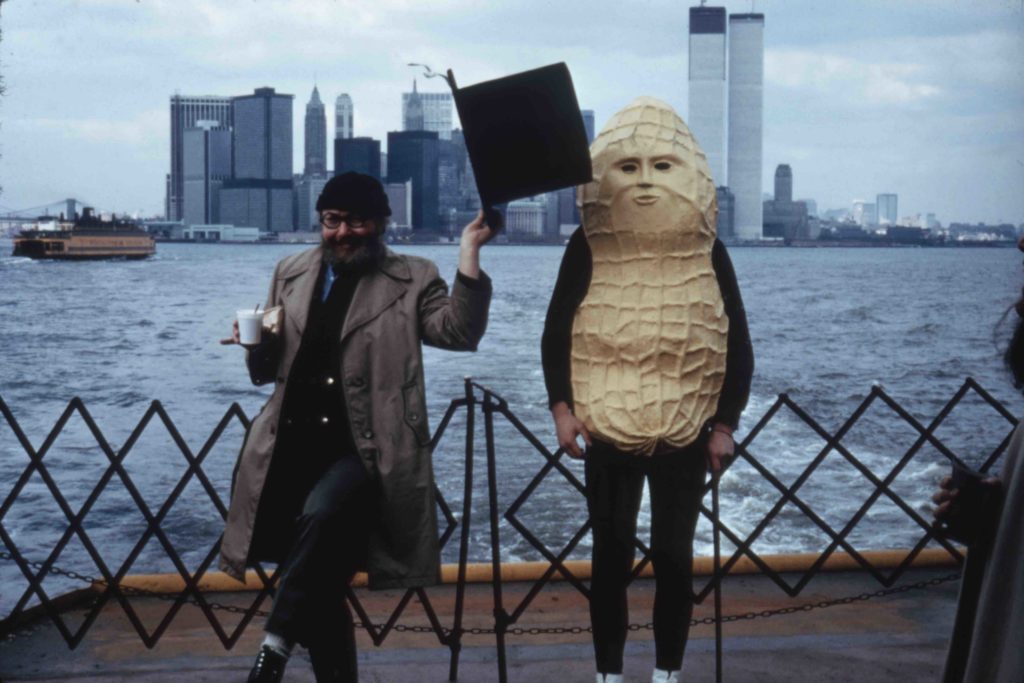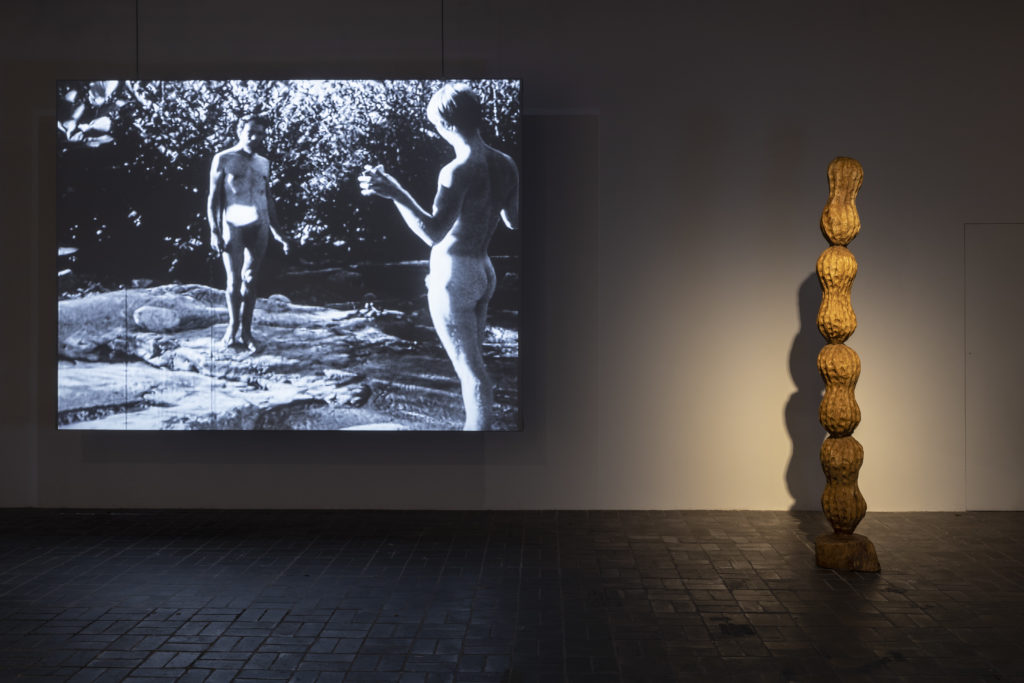Mr. Peanut Runs for Mayor: Image Bank // KW Institute for Contemporary Art
by Julianne Cordray

In the 1970s in Vancouver, Canada, Vincent Trasov and Michael Morris established the correspondence-focused artist collective, Image Bank—now emblematic of a practice that was at once distributive and acquisitional. The current Image Bank retrospective at the KW Institute for Contemporary Art in Berlin presents an extensive archive of correspondences in the form of written notes and postcards, as well as visual juxtapositions through collages, video compilations, props, and photographs, elucidating the often Duchampian approach to mass visual culture and language practiced by the network of artists. The exhibition touches upon a vein of ‘70s mail and correspondence art that has been in high circulation recently. Just across the street on Berlin Mitte’s Auguststraße, a recent exhibition at Museum Frieder Burda’s Salon Berlin featured the work of correspondence artist Ray Johnson (in collaboration with his estate, another archive), physically manifesting the network connectivity between these artists through their proximity in neighboring institutions. Johnson, and his New York School of Correspondence, had retained a close connection to Image Bank and its activities from the start—his letters and collages can be found among those displayed at KW.
In the exhibition halls, statements such as “Are words things?” or “The word is not dead: it is simply changing its skin,” are printed among the postcards that line the interior of a large central vitrine. These texts point to a use of words that is material, further articulated through the prevalence of puns, appropriated brand names, acronyms, and pseudonyms that crop up throughout the show.
The name ‘Image Bank’ itself was borrowed from William S. Burroughs’ novel, Nova Express (1964). Meanwhile, affixed to one large wall of the space is wallpaper printed with an artist directory and image request list compiled by Image Bank and published in FILE Megazine (1972–1989)—a publication of General Idea (another Canadian collective and close collaborator). The visual identity of FILE Megazine becomes quickly recognizable as a quotation of LIFE Magazine, appropriating the font, color, and layout of the magazine’s logo, and simply rearranging its letters. This cut-and-paste restructuring of elements was a characteristic mode of production employed by the artists, with the aim of opening up the possibility for new meanings to materialize, and thus unsettling dominant and accepted structures of the time in the process. This mode of upturning the system at once recalls the collage and assemblage techniques of a Dada tradition, while predating both institutional critique and current processes of mass image distribution.
Alongside the distribution and solicitation of images via mass mailing (which bears a strong correlation to the now extremely prevalent sharing and networking channels of the Internet), Image Bank’s work can be seen in parallel to alternative modes of production in contemporary art: namely, production as exchange, facilitated via the connective tissue of collective creative consciousness. Contemporary artist collectives, such as the Switzerland-based Louise Guerra Archive—which was initiated under the umbrella of a single alias—function as a mode of collective identity fabrication, akin to myth-making. Likewise, Image Bank artists were known for having established numerous interchangeable aliases in order to counter the notion of the solitary artist figure, underlining the fluidity of identity. Fluctuating between personas, the group dematerialized the distinction between manufacture and authenticity.
The most visible example of the aliases adopted by the artists of Image Bank is the character-performance of “Mr. Peanut,” a clear reference to the brand mascot from Planter’s Peanuts. The actual mayoral campaign of Mr. Peanut—undertaken during Vancouver’s municipal election in 1974—is documented throughout, with further peanut imagery, in its particular brand of recognizability and banality, dispersed and reappearing across all corners of the KW Institute space. Like Trasov’s peanut drawings, at times depicting an entanglement of peanuts, snaking, intestine-like, or his Eternal Peanut Column (1977), which stands at the exhibition’s entrance, the image of the peanut forms a strong visual link that ties together various media. These types of formal linkages, in fact, appear throughout the exhibition at different points, weaving the broader theme of connectivity—network building—into the physical layout of the exhibition itself.
The infiltration and destabilization of the institutional framework that supports the art world is at play in the very foundation of Image Bank. Their approach to traditional visual media, such as painting, is distilled down to its literal building blocks throughout the exhibition—whether in the form of gradating color bars, or geometric patches of light. These elements appear in different manifestations across the show: an installation of physical color bars float up from the floor in one darkened room, forming into pyramidal patterns across a spectrum of colors. Adjacent photo and video works show the color bars placed in a natural landscape, sometimes alongside the artists themselves, configured as static geometric structures among the grass and trees. Similarly, another video projection depicts the artists, naked and reflecting light onto one another’s bodies via a small mirror. Image Bank draws with light—enacting the function of light in image making in a material way.

This research impetus is revisited in another corner of the exhibition, wherein Morris’ work on paper, Eight Step Spectrum and Grey Scale (1970), is placed adjacently to Colour Research (1972–73), a segment of video that gives textual cues to consider the properties of light and surface. Collectively, this body of work is illustrative of a performative gesture that places the focus on process and communication rather than the art object as a closed, autonomous unit. Elements of painterly practice are transmuted into three-dimensional props and sets for an experimental mode of visual research and exploration. The geometric formations of bars of color, moreover, are evocative of analog pixels, facilitating further references to image construction—another type of ‘bank’.
As a whole, these works are enveloped in a soundscape by Canadian electronic composer Martin Bartlett, which escalates from an even-toned levity to a maddening, carnivalistic cacophony. This crescendo is visually accompanied by projections in the form of a triptych, flipping through catalogues of digitized slides at regular intervals. As the score builds, photos of Mr. Peanut engaged in a romantic encounter with General Idea’s Granada Gazelle pop up in a series across the wall. Directly across, Hands of the Spirit (1974)—also from General Idea, comprised of five hands made of clear Plexiglas with elongated, highly-gestural fingers attached to sticks—are propped up, their shadow-like presence adding to the overall effect of the psychedelic atmosphere. The sculptural hands, used as a prop within various contexts, reappear in documentation of the group’s performances—an emphatic articulation of artificiality injected into the realm of the real. Such forms of camp and theatricality serve as an extension of the impetus to counter traditional modes of visualization.
The notion of the archive, both as artistic mode of production and as a site for research and study seems to have taken a central position in recent years, as research-based art practices and collective modes of artistic production increasingly take shape. Through its breadth and frequent redundancy, the material displayed in the exhibition at KW enacts a visual and textual bombardment: a sort of simultaneity and anti-stasis that underscores the absurdity and superficiality of popular imagery in the context of capitalistic culture through its hyper-realization. Reacting to the illogical nature of contemporary culture and politics, Image Bank constructed an archival framework that played with notions of temporality and embraced paradoxes, while meticulously adhering to its own cataloguing, record-keeping, and system-absorbing tropes—regurgitating them to amass a decentralized, non-hierarchical structure. In short, Image Bank eludes simple categorization.
Image Bank ran at the KW Institute for Contemporary Art from June 22—September 19, 2019.